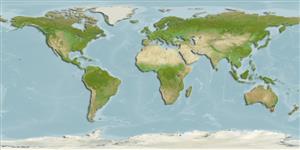Environment: milieu / climate zone / depth range / distribution range
Ecología
marino; agua dulce; salobre demersal; anfidromo (Ref. 51243). Temperate; 6°C - 20°C (Ref. 2060); 37°S - 44°S
Oceania: widely separated populations in southeastern and southwestern Australia.
Tamaño / Peso / Age
Maturity: Lm ? range ? - ? cm
Max length : 20.0 cm SL macho / no sexado; (Ref. 44894); common length : 10.0 cm SL macho / no sexado; (Ref. )
Facultative air-breathing in the genus (Ref. 126274); Occurs in still or slow-flowing waters at low elevations close to the sea; most abundant along shore margins in rocky areas. Found around plants, rocks or logs on the margins of still or flowing rivers, streams and lakes (Ref. 44894). The species has a marine juvenile stage, indicative of a diadromous life cycle. Spawning takes place from autumn to winter, among aquatic vegetation. Newly hatched larvae drift downcurrent and out to sea where they spend their first few months, eventually returning to fresh water during spring among annual whitebait migrations. In lacustrine and other landlocked populations, adults move upstream into feeder streams to spawn. The larvae are then swept downstream into lakes (Ref. 44894). Feeds mainly on aquatic and terrestrial insects.
Paxton, J.R., D.F. Hoese, G.R. Allen and J.E. Hanley, 1989. Pisces. Petromyzontidae to Carangidae. Zoological Catalogue of Australia, Vol. 7. Australian Government Publishing Service, Canberra, 665 p. (Ref. 7300)
IUCN Red List Status (Ref. 130435)
Threat to humans
Harmless
Human uses
Pesquerías: sin interés
Más información
Age/SizeCrecimientoLength-weightLength-lengthLength-frequenciesMorfometríaMorfologíaLarvaDinámica larvariaReclutamientoAbundanciaBRUVS
ReferenciasAcuiculturaPerfil de acuiculturaRazasGenéticaElectrophoresesheritabilidadEnfermedadesProcesamientoNutrientsMass conversion
ColaboradoresImágenesStamps, Coins Misc.SonidosCiguateraVelocidadTipo de nataciónSuperficie branquialOtolitosCerebrosVisión
Herramientas
Special reports
Download XML
Fuentes de Internet
Estimates based on models
Preferred temperature (Ref.
123201): 13.2 - 17.1, mean 15.4 °C (based on 135 cells).
Phylogenetic diversity index (Ref.
82804): PD
50 = 0.5000 [Uniqueness, from 0.5 = low to 2.0 = high].
Bayesian length-weight: a=0.00490 (0.00205 - 0.01170), b=3.12 (2.91 - 3.33), in cm total length, based on LWR estimates for this (Sub)family-body shape (Ref.
93245).
Nivel trófico (Ref.
69278): 2.9 ±0.45 se; based on food items.
Resiliencia (Ref.
120179): Medio, población duplicada en un tiempo mínimo de 1.4-4.4 años (Fec=1,175).
Fishing Vulnerability (Ref.
59153): Low vulnerability (14 of 100).
